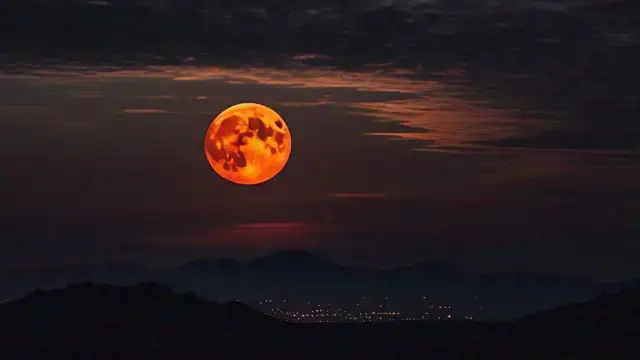Blood Moon Lunar Eclipse: A Stunning Night Sky Event
Get ready, stargazers! A total lunar eclipse commonly known as a “blood moon” is set to light up the night sky late Thursday. This celestial spectacle will turn the moon a deep, rusty red, creating a breathtaking sight you won’t want to miss. And here’s the kicker: if you skip this one, you’ll have to wait until March 2026 for the next chance to see a total lunar eclipse in the U.S.
So, what exactly is a blood moon? Who gets the best view? And why does the moon turn red? Let’s break it all down.
What Is a Blood Moon?
A blood moon occurs during a total lunar eclipse, when the Earth aligns perfectly between the sun and the moon. As the Earth’s shadow covers the moon, sunlight passing through our atmosphere bends and scatters, casting a reddish hue on the lunar surface.
Why Does the Moon Turn Red?
- Earth’s Atmosphere: The same phenomenon that makes sunrises and sunsets red tints the moon during an eclipse.
- Light Refraction: Only the longer wavelengths of light (reds and oranges) make it through the atmosphere, giving the moon its eerie glow.
It’s not just a pretty sight—it’s a reminder of how interconnected our solar system truly is.
Who Can See the Eclipse?
This lunar eclipse will be visible across North America, South America, western Europe, and parts of Africa. If you’re in the U.S., you’re in luck—you’ll have a front-row seat to the show.
Best Viewing Times (Eastern Time):
- Partial Eclipse Begins: 12:55 a.m. ET
- Total Eclipse Begins: 2:11 a.m. ET
- Maximum Eclipse: 2:59 a.m. ET
- Total Eclipse Ends: 3:47 a.m. ET
- Partial Eclipse Ends: 5:05 a.m. ET
The totality phase, when the moon is fully covered by Earth’s shadow, will last about 65 minutes. That’s plenty of time to soak in the beauty of the blood moon.
What Makes This Eclipse Special?
This isn’t just any lunar eclipse—it’s the first total lunar eclipse visible in the U.S. since November 2022. And with the next one not happening until March 2026, this is a rare opportunity to witness one of nature’s most stunning displays.
Key Moments to Watch:
- Penumbral Phase: The moon enters Earth’s lighter outer shadow, dimming slightly.
- Partial Eclipse: The moon begins to slip into the darker umbra, creating a dramatic “bite” out of the lunar surface.
- Totality: The moon turns a deep red, fully immersed in Earth’s shadow.
Whether you’re an avid astronomer or just someone who loves a good sky show, this eclipse is worth staying up for.
How to Watch the Lunar Eclipse
You don’t need fancy equipment to enjoy the eclipse—just your eyes and a clear view of the sky. But here are a few tips to make the most of the experience:
Tips for Viewing:
- Find a Dark Spot: Light pollution can dull the eclipse’s colors. Head to a park or rural area if you can.
- Dress Warmly: Late-night skywatching can get chilly, especially in March.
- Bring Binoculars: While not necessary, binoculars can enhance the view of the moon’s reddish hue.
- Check the Weather: Clear skies are a must. If it’s cloudy, consider streaming the event online.
And don’t forget to snap a photo or two! The blood moon makes for an unforgettable backdrop.
What Happens During a Lunar Eclipse?
A lunar eclipse occurs when the Earth, moon, and sun align in a straight line, with the Earth in the middle. Here’s a step-by-step breakdown of what happens:
The Process:
- Penumbral Phase: The moon enters Earth’s outer shadow, dimming slightly.
- Partial Eclipse: The moon moves into the umbra, Earth’s darker inner shadow.
- Totality: The moon is fully covered by the umbra, turning red.
- Reversal: The moon exits the umbra and penumbra, returning to its normal brightness.
The entire event can take up to 3 hours and 38 minutes, but the totality phase is the main attraction.
When Is the Next Lunar Eclipse?
If you miss this one, don’t worry—lunar eclipses aren’t exactly rare. From 2025 to 2030, there will be 14 lunar eclipses, with nine visible in the U.S.
Upcoming Eclipses:
- March 3, 2026: The next total lunar eclipse visible in the U.S.
- 2025-2030: A mix of partial and total eclipses, offering plenty of opportunities to catch the show.
While lunar eclipses happen relatively often, each one is unique. The timing, visibility, and even the moon’s color can vary, making every event special.
Why Do We Call It a Blood Moon?
The term “blood moon” has become popular in recent years, but it’s not an official astronomical term. It’s simply a poetic way to describe the moon’s reddish appearance during a total lunar eclipse.
Fun Fact:
- Cultural Significance: Many cultures have myths and legends tied to lunar eclipses, often associating them with omens or supernatural events.
While we now understand the science behind eclipses, there’s still something magical about watching the moon transform before your eyes.
Final Thoughts: Don’t Miss This Celestial Show
A total lunar eclipse is more than just a pretty sight—it’s a reminder of the wonders of our universe. Whether you’re a seasoned astronomer or just someone who loves a good sky show, this blood moon is an event you won’t want to miss.
So, set your alarm, grab a blanket, and head outside late Thursday night. The moon is putting on a show, and you’ve got a front-row seat.
P.S. If you snap any photos of the eclipse, share them online with the hashtag #BloodMoon2025. Let’s make this a night to remember!

